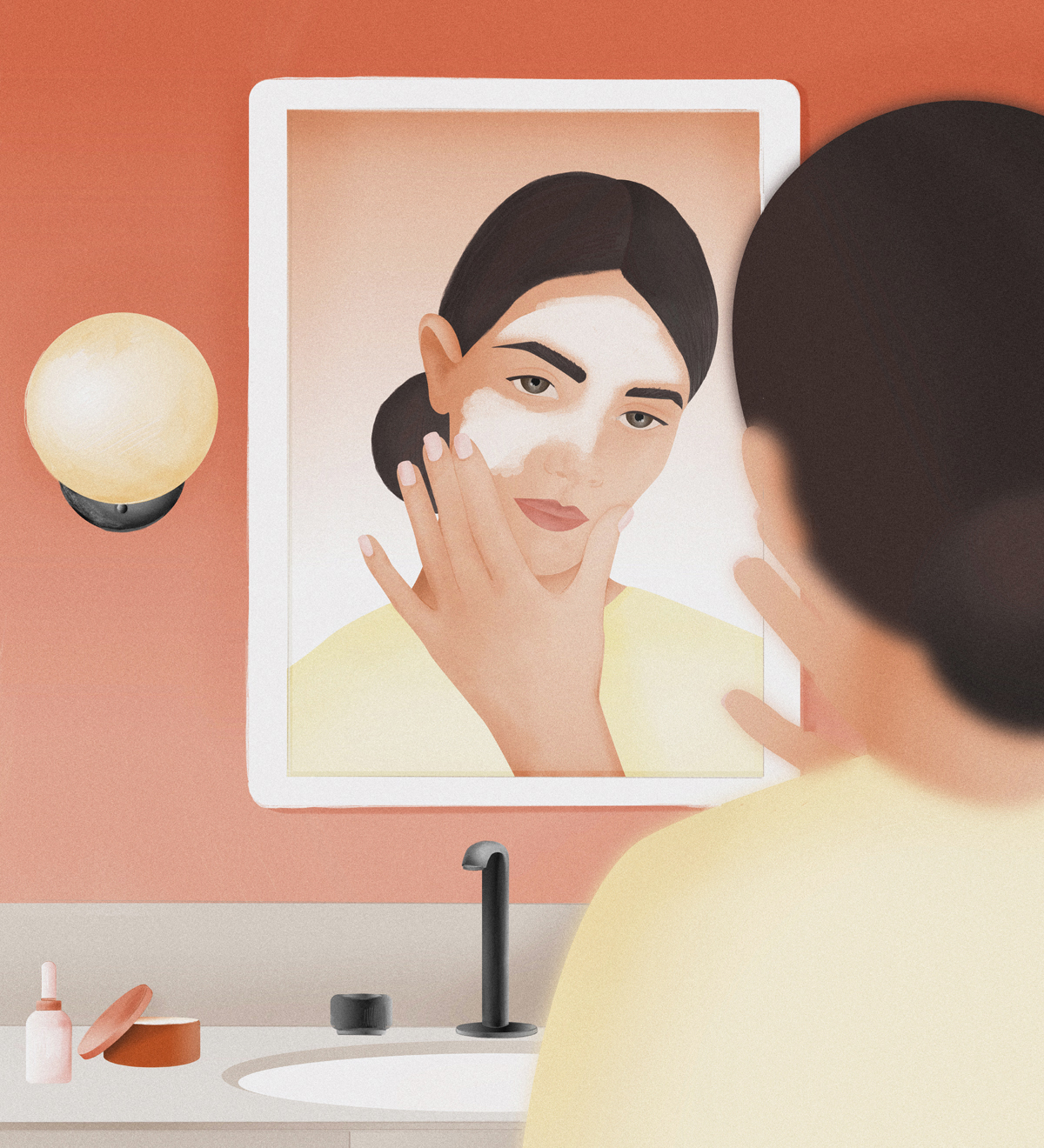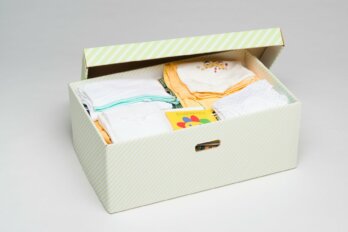Listen to an audio version of this story
For more audio from The Walrus, subscribe to AMI-audio podcasts on iTunes.
Last summer, five months into lockdown and two hours past midnight, I found myself glaring at my reflection in the bathroom mirror with five drops of Bertolli extra virgin olive oil drizzling down my nose. After an evening spent picking at my pores, I had found a buried Reddit thread suggesting I massage my skin with oil to rid it of the tiny grey spots that dotted its surface. These little nuisances—or “sebaceous filaments”—are not acne but passages that carry oil from the pores to the skin’s outer layer. Everyone has them, and they are not visible to the human eye except from an intimate distance. But, under lockdown, with the distance between my visage and the mirror shrinking with each passing day, I’d become obsessed with purging my face of these invaders.
My compulsive quest for a perfect complexion at this time was hardly unique. Last spring, according to the New York Times, skin care sales surpassed makeup in the United States for the first time. Market researchers at the NPD Group also reported that 40 percent of skin care consumers use products more frequently now than they did in 2019 and 22 percent of women say that the pandemic has caused them to expand their routines.
Listen to an audio version of this story
For more audio from The Walrus, subscribe to AMI-audio podcasts on iTunes.
Skin care was already seeing a surge in popularity before COVID-19. Social media has opened up new avenues for purchasing and discussing products and routines, so much so that the movement has spawned its own sizable YouTube subgenre. Celebrities from Rihanna to Alexandria Ocasio-Cortez have invited viewers into their bathrooms as they model their regimens, in some cases even suggesting that the process of cleansing, polishing, or moisturizing is inherently political. (“Femininity has power,” Ocasio-Cortez extols in her eighteen-minute video for Vogue.) Ten-step routines have been marketed as the height of self-care, and there are countless Facebook and Reddit groups dedicated to curing acne, banishing dark spots, and keeping wrinkles at bay.
The closure of the brick-and-mortar marketplace has allowed these online communities to blossom. “Skinfluencers,” who dish out advice and reviews on everything from serums and essences to at-home lasers, have seen major growth in their audience numbers since the start of COVID-19. Hyram Yarbro, who was crowned “Skincare Influencer of the Year” at the 2020 American Influencer Awards, has been posting videos on YouTube since 2017 and has gained over 3 million of his 4.55 million subscribers over the course of the pandemic. (On TikTok, he entered quarantine with 100,000 followers—today, he boasts more than 6.8 million.) And, as Yarbro points out, plenty of his biggest fans are men. As the world’s preeminent scientists raced to create COVID-19 vaccines, many of us engaged in science experiments of our own, alchemizing acids and retinoids to achieve that elusive “healthy glow.” What was once dismissed as a girlish pastime, it seems, has become both a coping mechanism and an attempt to defend our bodies from the outside world.
My prepubescent memories of skin care during the aughts are replete with neon pinks and fruity fragrances—a Neutrogena pink-grapefruit cleanser that left my face tingling and the now-notorious St. Ives apricot scrub that might as well have been sandpaper. The prevailing logic of the time was that pain meant efficacy and the walnut shards or microbeads excoriating your cheeks were doing exactly what they were designed to do. Now, the industry seems to have shifted toward more scientific (and, by proxy, less feminized) branding strategies. A collection of skin care products has become more akin to a personal apothecary than to a makeup vanity.
Take, for example, The Ordinary, the minimalist brand that has skyrocketed in popularity over the past few years and is a mainstay of Yarbro’s channel. Whereas more expensive brands tend to name serums and creams after vague aspirations (Tatcha’s The Dewy Serum and Sunday Riley’s Good Genes retail for $114 and $112, respectively), The Ordinary labels each product based on its main ingredients and keeps packaging simple (think No Name but for skin care). It encourages consumers to concoct formulas suited to their specific needs: you can buy “Niacinamide 10% + Zinc 1%” and “Hyaluronic Acid 2% + B5” for under $10 and prepare your own “brightening serum.” The solutions come outfitted in dropper bottles with austere black-and-white labels, a branding strategy meant to evoke medical dosages instead of cosmetic luxury.
“Skin care is health,” says Yarbro from his Honolulu residence. The day I call him, he’s been fielding media requests since dawn. Indeed, his clear complexion has been plastered across digital media outlets in the months since his channel took off, and he has been profiled by the New York Times, Vogue, and the Guardian. Unlike the wing-eyed, contoured influencers who trailblazed the Instagram beauty subculture of the 2010s, Yarbro is refreshingly bare faced. He films his videos from his verdant Hawaiian bedroom, a space that seems eternally Zen, the only pop of colour coming from his never-ending rotation of violet and cobalt hair dyes. Likewise, his videos have gained popularity because of his emphasis on ingredients over packaging. A former Saks Fifth Avenue makeup artist turned amateur scientist of sorts, he frequently reminds his viewers that he is not a dermatologist. But a typical video on Yarbro’s channel is almost like an introductory chemistry class: he compares alpha and beta hydroxy acids’ restorative properties with the affability and ease of a hip TA.
“Your skin is your largest organ,” he says. “Since the pandemic, we are seeing more of a mental connection between skin care and health—as opposed to skin care and aesthetics, like we see with makeup.”
My own skin care routine has become intertwined with COVID-19 precautions. I double-moisturize my hands because of the dryness from constant sanitizing. I am extra careful to cleanse my chin and jawline to prevent pimples arising from mask-wearing (“mascne,” as it has been dubbed). As the rules and restrictions governing daily life have proliferated, so too have the guidelines delineating my beauty routine. It may not be surprising to learn that taking care of our skin can be deeply psychological—an attempt to cleanse the body in an increasingly infected world.
In 1974, French psychoanalyst and Freud disciple Didier Anzieu first introduced the concept of “the skin-ego.” The skin-ego, he wrote, is a “psychic envelope” that defends the body—and the psyche—from external aggravators. Skin protects our insides both physically and in figures of speech: Don’t let it get under your skin; I’ve got thick skin. In a pandemic, when external infectants are not only everywhere but impossible to detect, the maintenance of this psychic envelope takes on newfound importance.
Marc Lafrance, an associate professor of sociology at Concordia University and a preeminent scholar of Anzieu, studies people’s experiences with acne and argues that skin-related anxieties have been exacerbated these days. Lafrance has weathered the pandemic in Sweden, where he holds a guest professorship at Örebro University and has been working on his newest project, the “Rule of Touch,” in which he plans to explore the psychology of pimple-popping. While his research is still in nascent stages, Lafrance asserts that pimple-popping “crystallizes a constellation of conflicts in relation to agency and autonomy, anger and aggression, control and mastery, and guilt and shame.” In other words, popping a pimple, a bodily invader you never asked for, is especially triumphant at a time when, as case counts remain high in some jurisdictions, fighting the rise of infection can feel increasingly futile.
“[Anzieu] helped us to think about how the body’s skin is far more than a cutaneous sheath,” Lafrance tells me over Zoom. “The pandemic is a very literal manifestation of how the skin serves as this interface between self and the world. It is an interface that is very fragile and very vulnerable, and it needs a lot of attention.”
Skin care has proliferated in the pandemic for myriad reasons, Lafrance explains. For one, practising “self-care” and other beauty routines are some of the only available pastimes while quarantining alone. But the process also speaks to something much more primal: the desire to control the self as normal life slides further and further from our grasp. It’s hardly a new phenomenon; however, such preoccupations are certainly heightened when any skin-to-skin contact risks contagion. Squeezing pimples and blackheads allows us to visualize the body’s infections in stark contrast to the maddeningly invisible coronavirus. Cloroxing countertops and sanitizing fingertips raw can feel like a blindfolded game of whack-a-mole. But, after puncturing a pimple, the release of sebum and pus provides the definitive satisfaction of having successfully expelled an infectant.
“There’s a way in which pimples get conditioned in our own minds as nonhuman actors—they’re us, but they’re not us at the same time,” Lafrance says. “Part of the reason that pimple-popping is so exciting is because it is a chance to reassert the agency of the subject rather than the object.”
The compulsion to master and control the imperfections in our skin is even more apparent when you consider the popularity of borderline-masochistic skin care treatments, like pore vacuums, dermarolling, and dermaplaning—wherein a dermatologist scrapes a surgery-grade scalpel against patients’ cheeks to remove peach fuzz, dead skin, and other obtrusive gunk. Superstar dermatologist Sandra Lee’s fame has risen to such a height that Dr. Pimple Popper, her show on TLC, has been granted a spin-off, Dr. Pimple Popper: Before the Pop. And brands haven’t shied away from satiating consumers’ impulses to pick, poke, prod, and satisfy quasi-Freudian desires to expel bodily fluids. Last April, Bioré marketed its infamous pore strips with a commercial that cautioned, “Warning: Oddly Satisfying Content Ahead.” The poreless model peels the strip off her nose, peering at its contents with a look somewhere between disgust and delight.
While there is a good deal of guilty pleasure to be found in a popped pimple, the new generation of consumers is also transitioning to a new approach. “For so long, we have viewed skin care as reparative rather than preventative,” Yarbro says. “I think Gen Z is the first audience that views skin care as truly preventative.” A must-have ingredient for Yarbro is retinol, the anti-aging elixir that promises to speed cell turnover and reduce the appearance of wrinkles, fine lines, and dark spots, all while treating acne. In a 2017 article for The New Yorker, “The Year that Skin Care became a Coping Mechanism,” Jia Tolentino described her foray into retinol as “one of many small, ridiculous attempts to affirm to myself that I will outlive the Trump Administration.” COVID-19 has rushed our fixations with mortality to the foreground, and it’s easier to curate an anti-aging skin care regimen than it is to ruminate about the inevitable. In quarantine, I have incorporated retinol and a vitamin C serum into my routine, on top of drinking two litres of water every day and slathering my skin with SPF 60 sunscreen despite rarely leaving the house—as any skinfluencer will tell you, the sun’s damaging rays can cause wrinkles and sunspots even through windows. I don’t just want to outlive the pandemic but to emerge as if I’ve been cryogenically frozen, the same twenty-two-year-old recent graduate who entered lockdown last March.
Last summer, when a close friend received a diagnosis of late-stage lymphoma, cosmetics continued to dominate discussion among my friends. In our group chat, which by then resembled many a “skin care addiction” Reddit thread, we tried to brainstorm suggestions for retinol alternatives since chemotherapy renders skin too sensitive for such harsh active ingredients. We conducted our own research and ended up mailing our friend Rachel Dermalogica’s Sensitive Skin Rescue Kit in time for the start of her treatment. In some ways, it felt like we were denying the stakes of what was happening, making-believe that there was no problem a gentle cleanser couldn’t fix. But it was also a relief to focus on the frivolous.
“You hear about people saying, ‘We have to resist the temptation to see the pandemic as an opportunity to optimize,’” Lafrance says. “But I think that working on the self has become a real hallmark of pandemic isolation because it’s one of the only things we can do, rightly or wrongly.” I can’t say that my skin or soul have benefited from nightly excavations of what lies beneath my epidermis. My reflection certainly looks nearly identical to how it did last March; as Ontario endured its third lockdown, waiting for Sephora packages began to feel like the only way to tell that time was really passing. Still, when collective responsibility and self-sacrifice dominate public discourse, skin care is a liberating exercise in vanity, selfishness, and control—or, at least, the illusion of it.





